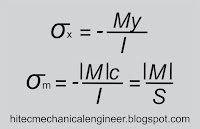Showing posts with label Mechanics of Materials-1. Show all posts
Engineering Mechanics Lab
By : Asad Ali Arshad |
| Engineering Mechanics Lab |
Rack-Pinion animation.mp4
null
Worm Gear.mp4
null
Cam and Follower Mechanism in Engine - Magic Marks_2.mp4
null
Cam and Follower.pptx
null
Rack-Pinion animation.mp4
null
How Bevel Gears Work.mp4
null
Gear Train Mechanism.pptx
null
Mechanics of Material
By : Asad Ali Arshad |
| Mechanics of Material Chapter no 6 |
Mechanics of Material
6_shearing_stresses.pdf
null
Chapter no 6
Shearing Stress in Beams and Thin Walled Members
In this we will discussed the following topic and these topics are discussed in detail in the above given slides.
Introduction
Transverse loading applied to a beam
results in normal and shearing stresses in
transverse sections.
Distribution of normal and shearing
stresses satisfies.
When shearing stresses are exerted on the
vertical faces of an element, equal stresses
must be exerted on the horizontal faces.
Longitudinal shearing stresses must exist
in any member subjected to transverse
loading.
- Shear on a horizontal face of a beam
- Solved Example Problem 6.1
- Determination of Shearing Stress in a Beam
- Shearing Stress in Common Types of a Beam
- Solved Example Problem 6.2
- Shearing Stress in Thin Walled Members
Mechanics of Material
By : Asad Ali Arshad |
| Mechanics of Material Chapter no 5 |
Chapter no 5 : Mechanics of Material
Analysis and Designs of Beam for Bending
In the above slides we will discussed this chapter in detail and solved some of the conceptual questions.
We will cover the following topics of this chapter
A safe design requires that the maximum normal stress be
less than the allowable stress for the material used. This
criteria leads to the determination of the minimum
acceptable section modulus.
Among beam section choices which have an acceptable
section modulus, the one with the smallest weight per unit
length or cross sectional area will be the least expensive
and the best choice
We will cover the following topics of this chapter
Introduction to this chapter
Objective - Analysis and design of beams
• Transverse loadings of beams are classified as
concentrated loads or distributed loads
• Applied loads result in internal forces consisting
of a shear force (from the shear stress
distribution) and a bending couple (from the
normal stress distribution)
• Normal stress is often the critical design criteria
 |
| Bending moment |
Requires determination of the location and
magnitude of largest bending moment.
Classification of Beams
Shear and Bending Moment Diagram
- Determination of maximum normal and shearing stress requires identification of maximum internal shear force and bending couple.
- Shear force and bending moment at a point determined by passing a section through the beam and applying an equilibrium analysis on the beam portions on either side of the section.
Solved Sample Problem 5.1
Solved Sample Problem 5.2
Relation between load shear and bending moment
Solved Sample Problem 5.3
Solved Sample Problem 5.4
Design of prismatic beams for bending
The largest normal stress is found at the surface where the
maximum bending moment occurs.
 |
| Bending Moment |
less than the allowable stress for the material used. This
criteria leads to the determination of the minimum
acceptable section modulus.
 |
| Section Modulus |
chap-5.pdf
null
Among beam section choices which have an acceptable
section modulus, the one with the smallest weight per unit
length or cross sectional area will be the least expensive
and the best choice
Solved Sample Problem 5.8
For more detail download the above slides..
Mechanics of Material
By : Asad Ali ArshadIn these slides following topic of the chapter no 2 are discussed in detail these are:
chap-2 (1).pdf
null
- Stress and Strain : Axial loading
- Normal Strain
- Stress Strain Curve
- Stress Strain Diagram: Ductile Material
- Stress Strain Diagram: Brittle Material
- Hooks Law Modulus of Elasticity
- Fatigue
- Deformation under Axial loading
- Generlized Hooks law
- Bulk Modulus
- Shearing Strain
- Relation among E, v and G
- Composite Material
- Saint-Venant's principle
- Stress Concentration Hole
- Stress Concentration fillet
- Elastoplastic Material
- Residual Stresses
- Poisson's Ratio
Mechanics of Material
By : Asad Ali ArshadThe content of this chapter are given below. All these topics are discussed in detail in the given slides and also alot of sample problems are solved for the convince of student.
Meet Google Drive - One place for all your files
Google Drive is a free way to keep your files backed up and easy to reach from any phone, tablet, or computer. Start with 15GB of Google storage - free.
- Concept of Stress
- Review of Statics
- Structure Free-Body Diagram
- Component Free-Body Diagram
- Method of Joints
- Stress Analysis
- Design
- Axial Loading: Normal Stress
- Centric & Eccentric Loading
- Shearing Stress
- Shearing Stress Examples
- Bearing Stress in Connections
- Stress Analysis & Design Example
- Rod & Boom Normal Stresses
- Pin Shearing Stresses
- Pin Bearing Stresses
- Stress in Two Force Members
- Stress on an Oblique Plane
- Maximum Stresses
- Stress Under General Loadings
- State of Stress
- Factor of Safety
Mechanics of Material
By : Asad Ali Arshadchap-4.pdf
null
In these slides we will discuss the chapter no 4 of mechanics of material which is related to the concepts of "Pure Bending". The aim of teaching this chapter are
Introduce students to bending behavior
Define the deformations, strains, and normal stresses in beams subject
to pure bending
Describe the behavior of composite beams made of more than one
material
Review stress concentrations and how they are included in the design
of beams
Study plastic deformations to determine how to evaluate beams made
of Elastoplast materials
Analyze members subject to eccentric axial loading, involving both
axial stresses and bending stresses
Review beams subject to unsymmetrical bending, i.e., where bending
does not occur in a plane of symmetry
Study bending of curved members
The content of this chapters are:
- Pure Bending
- Other Loading Types
- Symmetric Member in Pure Bending
- Bending Deformations
- Strain Due to Bending
- Beam Section Properties
- Properties of American Standard Shapes
- Deformations in a Transverse Cross Section
- Sample Problem 4.2
- Bending of Members Made of Several
- Materials
- Example 4.03
- Reinforced Concrete Beams
- Sample Problem 4.4
- Stress Concentrations
- Plastic Deformations
- Members Made of an Elastoplastic Material
- Example 4.03
- Reinforced Concrete Beams
- Sample Problem 4.4
- Stress Concentrations
- Plastic Deformations
- Members Made of an Elastoplastic Material
- Plastic Deformations of Members With a Single
- Plane of S...
- Residual Stresses
- Example 4.05, 4.06
- Eccentric Axial Loading in a Plane of Symmetry
- Example 4.07
- Sample Problem 4.8
- Unsymmetric Bending
- Example 4.08
- General Case of Eccentric Axial Loading
- 4 -
Mechanics of Material
By : Asad Ali Arshad
In these slides we will cover the following topics
chap-3.pdf
null
- Introduction
- Torsional Loads on Circular Shafts
- Net Torque Due to Internal Stresses
- Axial Shear Components
- Shaft Deformations
- Shearing Strain
- Stresses in Elastic Range
- Normal Stresses
- Torsional Failure Modes
- Sample Problem 3.1
- Angle of Twist in Elastic Range
- Statically Indeterminate Shafts
- Sample Problem 3.4
- Design of Transmission Shafts
- Stress Concentrations
- Plastic Deformations
- Elastoplastic Materials
- Residual Stresses
- Example 3.08/3.09
- Torsion of Noncircular Members
- Thin-Walled Hollow Shafts
- Introduce students to the concept of torsion in structural members and machine parts.
- Define shearing stresses and strains in a circular shaft subject to
- torsion
- Define angle of twist in terms of the applied torque, geometry of
- the shaft, and material
- Use torsional deformations to solve indeterminate problems
- Design shafts for power transmission
- Review stress concentrations and how they are included in torsion
- problems
- Describe the elastic-perfectly plastic response of circular shafts
- Analyze torsion for noncircular members
- Define the behavior of thin-walled hollow shafts
Mechanics of Material
By : Asad Ali Arshad
In these slides following topics are discussed in detail and some of the example problems related to these topics are also available.
The lecture 1 is actually Chapter 1 and Lecture 2 is Chapter 2 in both these to lecture we will basically complete two chapters of Mechanics of Material 7th Edition.
Chapter no 2 : Stress and Strain Axial Loading
The following topics are included in this chapter..
- Stress & Strain: Axial Loading
- Normal Strain
- Stress-Strain Test
- Stress-Strain Diagram: Ductile Materials
- Stress-Strain Diagram: Brittle Materials
- Hooke’s Law: Modulus of Elasticity
- Elastic vs. Plastic Behavior
- Fatigue
- Deformations Under Axial Loading
- Example 2.01
- Sample Problem 2.1
- Static Indeterminacy
- Example 2.04
- Thermal Stresses
- Poisson’s Ratio
- Generalized Hooke’s Law
- Dilatation: Bulk Modulus
- Shearing Strain
- Example 2.10
- Relation Among E, n, and G
- Sample Problem 2.5
- Composite Materials
- Saint-Venant’s Principle
- Stress Concentration: Hole
- Stress Concentration: Fillet
- Example 2.12
- Elastoplastic Materials
- Plastic Deformations
- Residual Stresses
- Example 2.14, 2.15, 2.16
2_axial_loading.pdf
null
Mechanics of Material
By : Asad Ali ArshadMechanics of Material Book 7th Edition is uploaded now you can get it through the following link.
Mechanics_of_Materials_7th_edition_beer..pdf
null
Hitec Mechanical Engineering
Mechanical Engineeirng Hitec Mechanical Engineering As we know Mechanical Engineering is the branch of engineering dealing with the des...
















